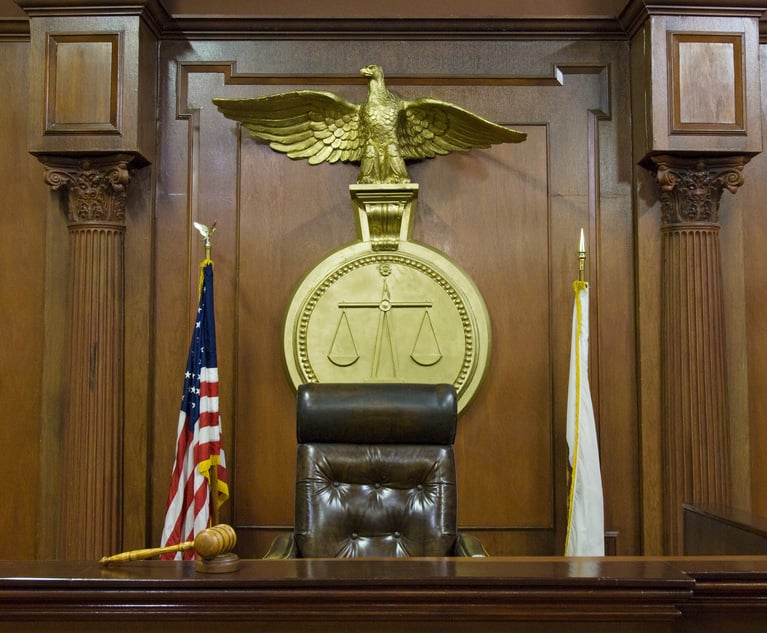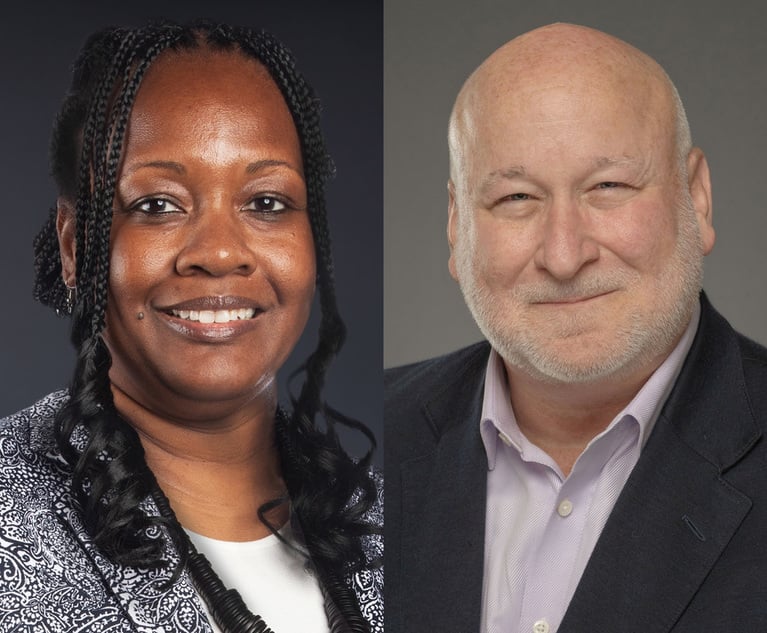Toxic Avengers
Environmental prosecutors await marching orders from the new administration.
March 31, 2009 at 08:00 PM
20 minute read
Corporate environmental crimes are often overshadowed by higher-profile shenanigans like accounting scandals, Foreign Corrupt Practices Act conspiracies and the occasional multibillion-dollar Ponzi scheme. The fines aren't as large, at least on the criminal side, and the actors are less prominent. Middle managers are far more likely to get cuffed than anyone in the corporate suite.
Moreover, environmental enforcers don't quite have the swagger of U.S. attorneys or DAs, and they are less likely to vie for the spotlight. Theirs is a scientific, methodical game, characterized by a dogged interagency collaboration.
But don't be fooled, the impact of an environmental conviction can do deep damage to a company's name and reputation, damage that can last a lot longer than fallout from the executive scandal du jour. And with the Obama administration's focus on environmental issues, the resources available to prosecutors are likely to increase.
“There's definitely going to be an increase in enforcement compared to the past eight years,” says Steven Murawski, an environmental partner at Baker & McKenzie. “So even if you're not an environmental attorney, you need to be able to recognize when an environmental crime has occurred and get the right experts in there.”
High-Impact Cases
That's not to say environmental prosecutors have been snoozing on the job. Even under the Bush administration, which was widely criticized for being soft on environmental issues, some experts contend enforcers maintained and even built upon an effective enforcement regime.
“I don't want to sound like an apologist for the Bush administration, but I think the perception [of lax environmental enforcement] was more extreme than the reality, particularly on the criminal side,” says Steven Shimberg, of counsel at DLA Piper, who was an administrator in the EPA's Office of Enforcement and Compliance Assurance during George W. Bush's first term. “The prosecution teams at EPA and [DOJ] were pretty busy. I think they did a good job over the last eight years of trying to refocus the program on the cases with the biggest environmental impact, and not go after a bunch of rinky-dink cases that are easy to do.”
Even so, Shimberg acknowledges that enforcement is likely to intensify in the new administration. But shifts in the political climate don't have as immediate an impact on environmental prosecutions as one might think. The cases involve long, complex investigations. Some initiatives are better measured in decades than election cycles. And it takes time to get people in place.
“I don't think our office has a single political [appointee] on board yet,” says Dave Ryan, a spokesman for the EPA's enforcement section. “It's too early in the game. The assistant administrator for enforcement and compliance assurance–the top enforcement person at EPA–is a political person, and they're not on board yet.”
Multiagency Investigation
Continuity is the theme at the Environmental Crimes Section, the Justice Department's nerve center for environmental prosecution. The section's 40 lawyers are all career employees–you have to go up the org chart to deputy AG before you reach a political appointee.
Because there's so much jurisdictional and departmental overlap in environmental regulation, the lawyers usually work in close collaboration with U.S. attorneys and state and local prosecutors, as well as the EPA, FBI and Department of Fish and Wildlife.
Investigations can be sprawling and usually focus on the most intentional, egregious and deceptive violations.
“Midnight dumping is a good example,” says Deputy Section Chief Kris Dighe. “Somebody dumps drums of hazardous chemicals in a ditch or a lake. A double set of books is another mark of deceptive conduct and makes a case more likely to be criminal.”
The Vessel Pollution Initiative is a prime example of the type of cases the section likes to attack–ones that combine intentional wrongdoing and deliberate evasion. The initiative began as an inquiry into cruise ships illegally dumping waste in the mid-1990s and has since mushroomed.
“We found that there were a lot of oil discharges happening in the high seas,” Dighe says. “So we started looking at cruise ships, and cargo ships as well. Foreign as well as domestic companies have been prosecuted.”
Ships are routinely fitted with pollution control systems, which monitor the effectiveness of filters that remove oil and pollutants before waste is pumped overboard. The prosecution team found widespread use of what is called a “magic pipe,” a bypass that circumvents the filters and pollution sensors altogether. They have collected in excess of $100,000 in criminal fines and sentenced individuals to more than 17 years in prison.
The section also frequently bundles investigations with other agencies to maximize resources. The Worker Endangerment Initiative, for example, combines investigations of environmental crimes with OSHA violations.
“Oftentimes environmental crimes are connected with worker injuries, or worker deaths,” Dighe says. “Part of it has to do with the organization of some companies. You'll find environmental, health and safety all grouped together. It's an area that is sometimes cut when industry is facing hard times.”
Tactical Wrinkles
The Environmental Crimes Section operates under the same prosecution guidelines as U.S. attorneys, but there is a key area where they diverge.
“Deferred prosecution agreements tend to be less of an option in environmental cases,” Dighe says. “Under most of our environmental statutes, there's an option of civil enforcement.”
That makes self disclosure critical. Unlike other corporate crimes where a nuanced discussion is sometimes appropriate about what, when and how much information to voluntarily disclose to the government, environmental laws offer clear paths toward civil resolution for companies that turn themselves in. When it comes to the prosecution of individuals, however, environmental prosecutors are in lock step with prevailing practice.
“The real way to achieve deterrence is prosecution of individuals who have culpability,” Dighe says. “If they realize they face the possibility of going to prison, most people who work for companies are going to be less likely to violate our statutes.”
Dighe is noncommittal about what changes he expects under the Obama Administration, but he says any increase in resources would be welcome. Given the new administration's environmental stance, there's reason to expect some movement.
“We have an optimistic view,” he says. “What it's going to mean to us on a day-to-day level we don't know yet.”
Corporate environmental crimes are often overshadowed by higher-profile shenanigans like accounting scandals, Foreign Corrupt Practices Act conspiracies and the occasional multibillion-dollar Ponzi scheme. The fines aren't as large, at least on the criminal side, and the actors are less prominent. Middle managers are far more likely to get cuffed than anyone in the corporate suite.
Moreover, environmental enforcers don't quite have the swagger of U.S. attorneys or DAs, and they are less likely to vie for the spotlight. Theirs is a scientific, methodical game, characterized by a dogged interagency collaboration.
But don't be fooled, the impact of an environmental conviction can do deep damage to a company's name and reputation, damage that can last a lot longer than fallout from the executive scandal du jour. And with the Obama administration's focus on environmental issues, the resources available to prosecutors are likely to increase.
“There's definitely going to be an increase in enforcement compared to the past eight years,” says Steven Murawski, an environmental partner at
High-Impact Cases
That's not to say environmental prosecutors have been snoozing on the job. Even under the Bush administration, which was widely criticized for being soft on environmental issues, some experts contend enforcers maintained and even built upon an effective enforcement regime.
“I don't want to sound like an apologist for the Bush administration, but I think the perception [of lax environmental enforcement] was more extreme than the reality, particularly on the criminal side,” says Steven Shimberg, of counsel at
Even so, Shimberg acknowledges that enforcement is likely to intensify in the new administration. But shifts in the political climate don't have as immediate an impact on environmental prosecutions as one might think. The cases involve long, complex investigations. Some initiatives are better measured in decades than election cycles. And it takes time to get people in place.
“I don't think our office has a single political [appointee] on board yet,” says Dave Ryan, a spokesman for the EPA's enforcement section. “It's too early in the game. The assistant administrator for enforcement and compliance assurance–the top enforcement person at EPA–is a political person, and they're not on board yet.”
Multiagency Investigation
Continuity is the theme at the Environmental Crimes Section, the Justice Department's nerve center for environmental prosecution. The section's 40 lawyers are all career employees–you have to go up the org chart to deputy AG before you reach a political appointee.
Because there's so much jurisdictional and departmental overlap in environmental regulation, the lawyers usually work in close collaboration with U.S. attorneys and state and local prosecutors, as well as the EPA, FBI and Department of Fish and Wildlife.
Investigations can be sprawling and usually focus on the most intentional, egregious and deceptive violations.
“Midnight dumping is a good example,” says Deputy Section Chief Kris Dighe. “Somebody dumps drums of hazardous chemicals in a ditch or a lake. A double set of books is another mark of deceptive conduct and makes a case more likely to be criminal.”
The Vessel Pollution Initiative is a prime example of the type of cases the section likes to attack–ones that combine intentional wrongdoing and deliberate evasion. The initiative began as an inquiry into cruise ships illegally dumping waste in the mid-1990s and has since mushroomed.
“We found that there were a lot of oil discharges happening in the high seas,” Dighe says. “So we started looking at cruise ships, and cargo ships as well. Foreign as well as domestic companies have been prosecuted.”
Ships are routinely fitted with pollution control systems, which monitor the effectiveness of filters that remove oil and pollutants before waste is pumped overboard. The prosecution team found widespread use of what is called a “magic pipe,” a bypass that circumvents the filters and pollution sensors altogether. They have collected in excess of $100,000 in criminal fines and sentenced individuals to more than 17 years in prison.
The section also frequently bundles investigations with other agencies to maximize resources. The Worker Endangerment Initiative, for example, combines investigations of environmental crimes with OSHA violations.
“Oftentimes environmental crimes are connected with worker injuries, or worker deaths,” Dighe says. “Part of it has to do with the organization of some companies. You'll find environmental, health and safety all grouped together. It's an area that is sometimes cut when industry is facing hard times.”
Tactical Wrinkles
The Environmental Crimes Section operates under the same prosecution guidelines as U.S. attorneys, but there is a key area where they diverge.
“Deferred prosecution agreements tend to be less of an option in environmental cases,” Dighe says. “Under most of our environmental statutes, there's an option of civil enforcement.”
That makes self disclosure critical. Unlike other corporate crimes where a nuanced discussion is sometimes appropriate about what, when and how much information to voluntarily disclose to the government, environmental laws offer clear paths toward civil resolution for companies that turn themselves in. When it comes to the prosecution of individuals, however, environmental prosecutors are in lock step with prevailing practice.
“The real way to achieve deterrence is prosecution of individuals who have culpability,” Dighe says. “If they realize they face the possibility of going to prison, most people who work for companies are going to be less likely to violate our statutes.”
Dighe is noncommittal about what changes he expects under the Obama Administration, but he says any increase in resources would be welcome. Given the new administration's environmental stance, there's reason to expect some movement.
“We have an optimistic view,” he says. “What it's going to mean to us on a day-to-day level we don't know yet.”
This content has been archived. It is available through our partners, LexisNexis® and Bloomberg Law.
To view this content, please continue to their sites.
Not a Lexis Subscriber?
Subscribe Now
Not a Bloomberg Law Subscriber?
Subscribe Now
NOT FOR REPRINT
© 2024 ALM Global, LLC, All Rights Reserved. Request academic re-use from www.copyright.com. All other uses, submit a request to [email protected]. For more information visit Asset & Logo Licensing.
You Might Like
View All
Elaine Darr Brings Transformation and Value to DHL's Business

How Marsh McLennan's Small But Mighty Legal Innovation Team Builds Solutions That Bring Joy

Democratic State AGs Revel in Role as Last Line of Defense Against Trump Agenda
7 minute readTrending Stories
- 1'America's Next Top Model' Contestant Says Ye Assaulted Her
- 2LexisNexis Responds to Canadian Professor’s Criticism of Lexis+ AI
- 3'Everything Leaves a Digital Footprint': How to Navigate the Complexities of Internal Investigations
- 4Baker McKenzie Accepts Defeat on Australian Integration With Firm's Asia Practice
- 5PepsiCo's Legal Team Champions Diversity, Wellness, and Mentorship to Shape a Thriving Corporate Culture
Who Got The Work
Michael G. Bongiorno, Andrew Scott Dulberg and Elizabeth E. Driscoll from Wilmer Cutler Pickering Hale and Dorr have stepped in to represent Symbotic Inc., an A.I.-enabled technology platform that focuses on increasing supply chain efficiency, and other defendants in a pending shareholder derivative lawsuit. The case, filed Oct. 2 in Massachusetts District Court by the Brown Law Firm on behalf of Stephen Austen, accuses certain officers and directors of misleading investors in regard to Symbotic's potential for margin growth by failing to disclose that the company was not equipped to timely deploy its systems or manage expenses through project delays. The case, assigned to U.S. District Judge Nathaniel M. Gorton, is 1:24-cv-12522, Austen v. Cohen et al.
Who Got The Work
Edmund Polubinski and Marie Killmond of Davis Polk & Wardwell have entered appearances for data platform software development company MongoDB and other defendants in a pending shareholder derivative lawsuit. The action, filed Oct. 7 in New York Southern District Court by the Brown Law Firm, accuses the company's directors and/or officers of falsely expressing confidence in the company’s restructuring of its sales incentive plan and downplaying the severity of decreases in its upfront commitments. The case is 1:24-cv-07594, Roy v. Ittycheria et al.
Who Got The Work
Amy O. Bruchs and Kurt F. Ellison of Michael Best & Friedrich have entered appearances for Epic Systems Corp. in a pending employment discrimination lawsuit. The suit was filed Sept. 7 in Wisconsin Western District Court by Levine Eisberner LLC and Siri & Glimstad on behalf of a project manager who claims that he was wrongfully terminated after applying for a religious exemption to the defendant's COVID-19 vaccine mandate. The case, assigned to U.S. Magistrate Judge Anita Marie Boor, is 3:24-cv-00630, Secker, Nathan v. Epic Systems Corporation.
Who Got The Work
David X. Sullivan, Thomas J. Finn and Gregory A. Hall from McCarter & English have entered appearances for Sunrun Installation Services in a pending civil rights lawsuit. The complaint was filed Sept. 4 in Connecticut District Court by attorney Robert M. Berke on behalf of former employee George Edward Steins, who was arrested and charged with employing an unregistered home improvement salesperson. The complaint alleges that had Sunrun informed the Connecticut Department of Consumer Protection that the plaintiff's employment had ended in 2017 and that he no longer held Sunrun's home improvement contractor license, he would not have been hit with charges, which were dismissed in May 2024. The case, assigned to U.S. District Judge Jeffrey A. Meyer, is 3:24-cv-01423, Steins v. Sunrun, Inc. et al.
Who Got The Work
Greenberg Traurig shareholder Joshua L. Raskin has entered an appearance for boohoo.com UK Ltd. in a pending patent infringement lawsuit. The suit, filed Sept. 3 in Texas Eastern District Court by Rozier Hardt McDonough on behalf of Alto Dynamics, asserts five patents related to an online shopping platform. The case, assigned to U.S. District Judge Rodney Gilstrap, is 2:24-cv-00719, Alto Dynamics, LLC v. boohoo.com UK Limited.
Featured Firms
Law Offices of Gary Martin Hays & Associates, P.C.
(470) 294-1674
Law Offices of Mark E. Salomone
(857) 444-6468
Smith & Hassler
(713) 739-1250







